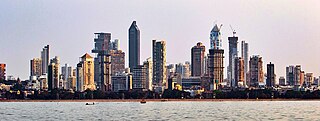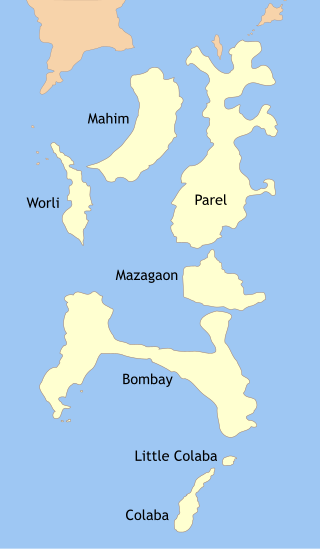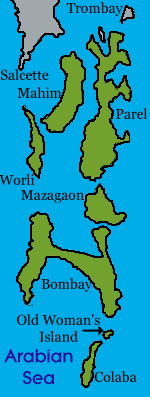
Mumbai is the capital city of the Indian state of Maharashtra. Mumbai is the financial capital and the most populous city of India with an estimated population of 12.5 million (1.25 crore). Mumbai is the centre of the Mumbai Metropolitan Region, the sixth-most populous metropolitan area in the world with a population of over 23 million. Mumbai lies on the Konkan coast on the west coast of India and has a deep natural harbour. In 2008, Mumbai was named an alpha world city. Mumbai has the highest number of billionaires out of any city in Asia.
The climate of Mumbai is tropical, with defined wet and dry seasons. The mean annual temperature is 27.7 °C or 81.9 °F. Average annual rainfall is 2,213.4 millimetres or 87 inches in Colaba, which represents South Mumbai and 2,502.3 millimetres or 99 inches in Santacruz, which represents central and suburban Mumbai. The mean maximum average temperatures is about 32 °C (90 °F) in summer and 30 °C (86 °F) in winter, while the average minimums are 26 °C (79 °F) in summer and 18 °C (64 °F) in winter. The city experiences a lengthy, practically rainless dry season, and a relatively short, but extremely rainy wet season; due to the Southwest Monsoon and orographic influences from the nearby Western Ghats.These conditions effectively place Mumbai between a Tropical monsoon climate (Am) and a Tropical savannah climate (Aw), with more tilt towards the former considering annual precipitation.

Colaba is a part of the city of Mumbai, India. It is one of the four peninsulas of Mumbai while the other three are Worli, Bandra and Malabar Hill. During Portuguese rule in the 16th century, the island was known as Kolbhat. After the British took over the island in the late 17th century, it was known as Kolio.

Mumbai Central is a major railway station on the Western line, situated in Mumbai, Maharashtra in an area known by the same name. It serves as a major stop for both Local and Inter-City/Express trains with separate platforms for them. It is also a terminal for several long-distance trains including the Mumbai Rajdhani Express.

The Seven Islands of Bombay were 16th-century Portuguese colonial possessions lying off the Konkan region by the mid-west coast of India.

South Mumbai, colloquially SoBo from South Bombay in Indian English, administratively the Mumbai City District, is the city centre and the southernmost precinct of Greater Bombay. It extends from Colaba to Mahim and Sion neighbourhoods, and comprises the city's main business localities, making it the wealthiest urban precinct in India. Property prices in South Mumbai are by far the highest in India and among the highest in the world. In terms of Vidhansabha it is further divided in two parts - South and South Central. South has areas like Fort Colaba Girgaon to Worli Dadar and Prabhadevi, whereas South Central has Chembur, Wadala, Sion and Mahim.

Mumbai Harbour, is a natural deep-water harbour in the southern portion of the Ulhas River estuary. The narrower, northern part of the estuary is called Thana Creek. The harbour opens to the Arabian Sea to the south. The historical island of Elephanta is one of the six islands that lie in the harbour.

Isle of Bombay was one of the Seven Islands of Bombay, an archipelago of islands that were, in the eighteenth century, connected to form the area of the modern city of Bombay in India. The island was the main harbour and the Base of the British from where the city expanded.

The David Sassoon Library and Reading Room is a famous library and heritage structure in Mumbai, India. The idea for a library to be situated in the center of the city came from Albert Sassoon, son of the famous Baghdadi Jewish philanthropist, David Sassoon.

Chinchpokli is a neighbourhood in South Mumbai. It is also the name of a railway station on the Central line of the Mumbai suburban railway. Historical British era spellings include Chinchpugli and Chinchpooghly. The neighbourhood is named after the Marathi words for tamarind (chinch) and betel nut (pofali).

Navy Nagar is a cantonment area in Mumbai, India, and was established in 1796. The area is owned and managed solely by the Indian Navy and entry to this area is highly restricted. Entry and exit points to the area are heavily manned by Naval Police.

Bhaucha Dhakka is a wharf along the Thane Creek, along the coast of Dockyard Road on the Eastern seafront of Mumbai, the capital of the Indian state of Maharashtra. The wharf serves as the port for numerous fishermen who bring in their daily catch. Ferry services link up JNPT, Uran to the east, and Rewas and Mandwa to the south. The wharf is used by the students of the Training Ship Rahaman which is an institute for maritime studies on the island of Nhava.

The Royal Bombay Yacht Club (RBYC) is one of the premier gentlemen's clubs which was founded in 1846 in Colaba, an area of Mumbai in India. The building was designed by John Adams, who also designed the nearby Royal Alfred Sailors' Homes, and was completed in 1896.
Colaba Causeway, officially known as Shahid Bhagat Singh Road, is a commercial street, and a major causeway or land link between Colaba and the Old Woman's Island in the city of Mumbai, India.
Colaba Observatory, also known as the Bombay Observatory, was an astronomical, timekeeping, geomagnetic and meteorological observatory located on the Island of Colaba, Mumbai (Bombay), India.
Indigenous tribals have inhabited Mumbai (Bombay) since the Stone Age. The Kolis and Aagri were the earliest known settlers of the islands. Between the 2nd century BCE and 10th century CE, the islands came under the control of successive indigenous dynasties: the Satavahanas, Abhiras, Vakatakas, Kalachuris, Konkan Mauryas, Chalukyas, Rashtrakutas, Silharas & Cholas.

Bombay, also called Bom baim in Portuguese, is the financial and commercial capital of India and one of the most populous cities in the world.
The 1947 Ramdas ship disaster occurred near Bombay in India. The Indian passenger ship SS Ramdas, while bound for Rewas in Maharashtra, capsized on 17 July 1947, near Gull Island, ten miles from Colaba(South Mumbai)Point, killing 724 of the people on board.

Colaba Assembly constituency is one of the 288 Vidhan Sabha constituencies of Maharashtra state within Mumbai City in western India. Rahul Narwekar of the BJP is currently the MLA of Colaba Constituency

Sassoon Docks, built in 1875, is one of the oldest docks in Mumbai and was the first wet dock constructed in Bombay. It is one of the few docks in the city open to the public. It is situated in Mumbai harbour in South Mumbai area of Colaba. It is one of largest fish markets in the Mumbai city, it has a wide variety of fishes, including Surmai, pomfret etc. Its neighbouring features are Mumbai Port Trust Garden and Offices of Fisheries Department, and it overlooks Oyster Rock, an island in the Mumbai harbour, at a distance.















